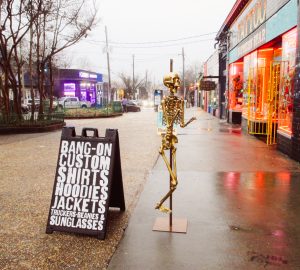Fourth-year interior design student Victoria Arenz proves that fashion always has a say in some of the most important interior design choices. Arenz takes inspiration from designer looks and select fabrics, prints and color combinations.

The Connector: How would you define interior design’s relationship with fashion?
Arenz: I feel like interior design and fashion play off of each other. When looking at trends, old or new, you can see similarities in color, shape, contrast, pattern and even textures.
The Connector: What aspects do you look for in fashion that you think will be beneficial to your interior design work?
Arenz: When I look at fashion for inspiration, I like looking at patterns and the use of positive and negative space. In many of my interior design classes, our professors have us go to SCAD FASH and make us incorporate one of the pieces in our work somehow. I was taking hospitality design when the Mary Katrantzou exhibition had just opened, and I drew inspiration from a two piece outfit that had a repeated “H” pattern. My hypothetical client was the Edition Hotel brand and I wanted to mimic that pattern but with an “E” for a wall covering on the back wall of a bar.
The Connector: What’s your design aesthetic like?
Arenz: My design aesthetic and how I design are always changing and adapting based on new knowledge I gain from my classes or places I travel to. Something that remains constant for me when I design is studying the history of the site location and client and working to bring forth that history — I think it makes the design stronger and builds the connection between the user and the space.

The Connector: What does your ideal study room look like?
Arenz: My capstone project is a residence hall in which I wanted to incorporate study rooms and pods. I would focus a lot on acoustics so maybe an interesting acoustical ceiling design or wall paneling. Comfortable furniture groupings to encourage both group work and personal studying, and maybe a wood laminate flooring with a cork underlay to reduce noise. The use of a color that would both excite the students to learn but not overwhelm and some windows to bring in natural light or lighting to imitate natural light.
The Connector: What main interior design characteristics should an apparel store have?
Arenz: Brick-and-mortar stores are fading away due to the rise of technology and online shopping, it’s up to us designers to create a memorable experience for the customers. In retail, lighting is so important because not everything looks great under the same light, their use of hierarchy creates visual interest. As for branding, whether it’s the color, logo, smell or material that is featured, it’s vital to help the customer remember why they would want to shop at one store as opposed to another.
The Connector: Talk about a project you’re proud of or is the best one you’ve done.
Arenz: As a designer, I feel like we’re always improving our skills and knowledge in our respected fields and critiquing ourselves. I am quite hard on myself whenever I finish a project because I know that I can do better. Whenever I think I should do more, I like to remember a quote from Frank Lloyd Wright, “Less is more when more isn’t good enough.” I have pieces from projects that I’m proud of — one was a kitchen from my workplace design class in which Sundance was my client. I wanted to stay true to the roots of the company as well as their branding, while creating a very trendy eating area that takes the user away from the work headspace. Another piece I look up to is a double guest room from my hotel design class that introduces a unique yet functional layout that stays true to the concept and hotel brand, the Edition Hotel.






















